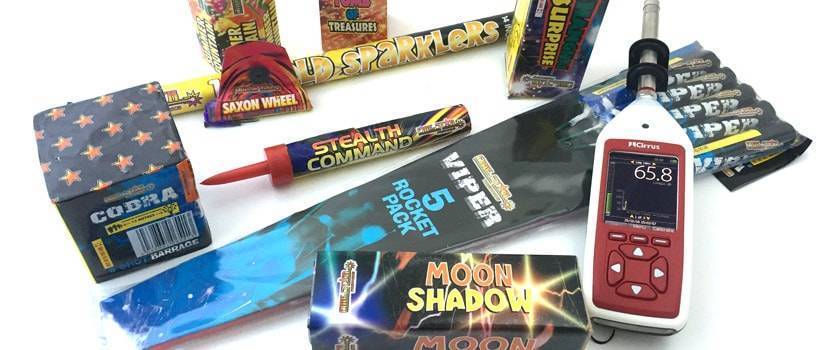Diwali, Bonfire Night and New Year’s Eve. Three events that are synonymous with fireworks. They would not be the same without the whizz, bang and wallop. However, some fireworks can be more of a damp squib than out of this world when it comes to the big bang factor. That is why we put some of the most popular fireworks to the test to see which ones deliver more bang for your buck.
More than £100m is spent on fireworks in the UK every year. We bought a standard selection box of fireworks from a well-known supermarket for £20. The idea was to test 20 different fireworks to see what noise levels were reached, with some surprising results.
Legislation on Firework Noise Levels
Strict legislation governs the fireworks’ fire power that manufacturers can sell to the general public. Guidelines on how far away members of the public should be to protect them from a variety of hazards, including hearing damage are included. Home-use fireworks are supposed to have a noise limit of 120 decibels (dBs) when fired from 15 metres away. Anything above this noise limit cannot be sold to the general public.
The Results of our Firework Noise Measurements
The firework noise monitoring was completed using an Optimus Green Class 1 Sound Level Meter.
We decided to use the LAFmax parameter to determine which firework was the loudest. LAFmax is the maximum sound level during the measurement period, which has been ‘A’ Weighted to reflect the response of the human ear to noise. We also used the LCPeak to tell us the actual Peak during the measurement. Download ‘A Guide to Noise Measurement Terminology’ to learn about the most common acoustic terms.
| Measurement # | Firework Name | Duration MM:SS | LAFmax (dB) | LCPeak (dB) |
| 11 | Viper Rocket (grounded) | 00:16 | 111.7 | 140.4 |
| 2 | 8 Shot Barrage | 00:27 | 103.8 | 131.7 |
| 15 | Dancing Butterfly | 00:20 | 99.9 | 124.2 |
| 10 | Viper Rocket (central lift off) | 00:32 | 99.8 | 127.6 |
| 3 | Moon Shadow | 00:29 | 99.6 | 125.1 |
| 8 | Tomb of Treasures | 00:20 | 98.4 | 123.8 |
| 17 | Flower Pot | 00:51 | 96.5 | 121.5 |
| 12 | Opal Orchard | 00:36 | 96.1 | 104.1 |
| 16 | Shanghai Surprise | 00:42 | 95.9 | 124.1 |
| 4 | Clustering Butterflies | 00:23 | 94.9 | 121.8 |
| 9 | Viper Rocket (off-course) | 00:16 | 92.8 | 122.1 |
| 6 | Serpents | 00:19 | 92.3 | 121.3 |
| 5 | Stealth Command | 00:14 | 91.7 | 122.6 |
| 18 | Spring Flower | 05:01 | 91.7 | 116.4 |
| 13 | Magical Castle | 00:14 | 80.4 | 107.4 |
| 19 | Saxon Wheel | 00:18 | 76.9 | 90.3 |
| 7 | Crackling Snow | 00:27 | 70.1 | 100.2 |
| 20 | Sparklers 2nd version | 01:03 | 67.8 | 92.1 |
| 1 | Sparklers | 05:07 | 65.4 | 83.2 |
| 14 | Summer Fountain | 00:29 | 63.4 | 94 |
Of the 20 fireworks tested, the Viper Rocket came out top with a LAFMax (dB) reading of 111.7 with a Peak noise at 140.4 – the equivalent of a plane taking off.
Second came the 8 Shot Barrage, a series of small rockets released in quick succession, that registered 103.8 dB, with a Peak of 131.7 – equal to a pneumatic drill in use.
In third place came the Dancing Butterfly – a ground based sparkling shower effect – packing a powerful punch of 99.9 dB and a Peak of 124.2. This made more noise than a chain saw or electric drill – and lasted a very respectable 20 seconds into the bargain.
Rockets obviously delivered a big bang for your buck but didn’t last that long. On average between 15-20 seconds. The other fireworks from our repertoire often came in only marginally quieter but lasted twice, sometimes three times as long. In that respect, they give you much more value for money.



